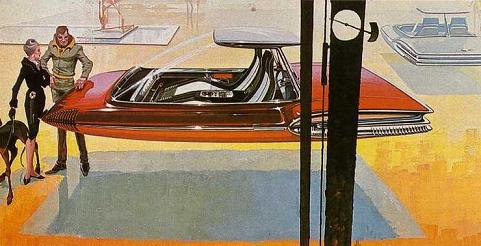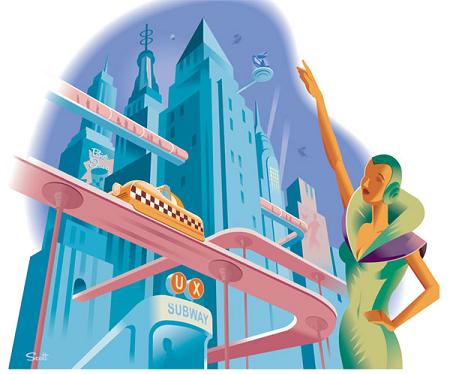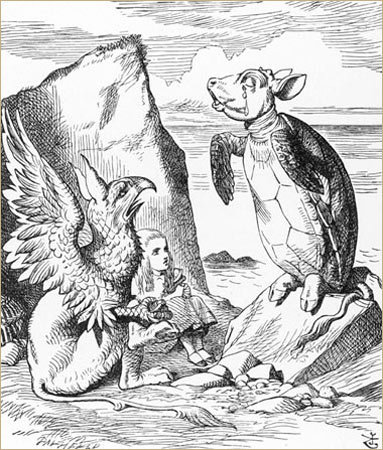Everybody has a different concept of “The Future”. A few weeks ago I was asked by The New York Times, along with nine other New Yorkers, to predict what our fair city would be like in another hundred years. The resulting article, still available on-line, was called The World of Tomorrow.
Of all the ideas in that article, my hands-down favorite comes from Kate Kaplan, the only non-adult in the bunch (she’s in the seventh grade), who optimistically predicts:
“You’ll no longer have to worry about finding a bathroom; you’ll just carry a small chip with you that can expand into a private portable toilet.”
It’s good to know that at least one person is thinking about the really important things.
I’ve been thinking that one way to measure people’s attitudes toward the future is by seeing what kind of flying car they prefer. The evidence suggests that around fifty years ago lots of people were playing this game, but that it has kind of died out in recent years. Maybe it’s time to bring it back.
Of course all little kids know that the flying car is a key accessory for any self-respecting future family:

But what about bigger kids? I’ve been poking around, and have found a few flying car visions that seem particularly fun. I especially like this one, because it looks like the perfect mid-century suburban dream car, but with the convenient addition of that handy-dandy antigravity drive:

Then there are the contributions of the great Syd Mead, the futurologist illustrator who pretty much invented what people now think the future looks like (all those trapezoids, in everything from Star Trek to Star Wars to Blade Runner, can be traced back to his fevered pen). Here he shows us the flying car as the very epitome of chic and sexy cool:

At the other extreme is the lone inventor longing to perfect his eccentric vision of personal flight. It is said that ago he disappeared into his mad scientist’s workshop, toiling away for years on end while neglecting to eat, sleep or bathe. People wonder what has become of him. Until that one fateful day when he at last emerges, triumphant, vindicated, if maybe a little freaked out by all that bright sunlight:

Then there is that recurring dream of ultimate lifestyle freedom: To embrace technology yet somehow be at one with nature. The car here allows its happy owners to fly right to the door of their woodland dream home. There is even the subliminal suggestion that when you’re done soaring over sun-dappled lakes and forests, you might be able to barbeque right on that humongous grill:

There is a kind of poignant irony to the above picture: We now know that the fuel costs of such a beast would render it about as un-ecological a lifestyle choice as you could imagine.
There are so many possible flying cars, each one promising its own vision for the future; a hopeful offering, rendered in technology, to the gods of Utopia.
What does your flying car look like?









